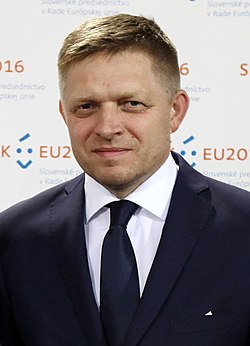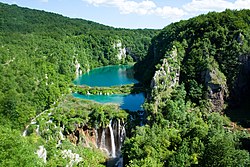Novalia
This article is incomplete because it is pending further input from participants, or it is a work-in-progress by one author. Please comment on this article's talk page to share your input, comments and questions. Note: To contribute to this article, you may need to seek help from the author(s) of this page. |
Republic of Novalia Republika Novalija | |
|---|---|
| Novalia in red, Etruria in grey Novalia in red, Etruria in grey | |
| Status | Constituent State of Etruria |
| Capital | Vilanija |
| Largest | Dubovica |
| Official languages | Italian Croatian Slovenian |
| Ethnic groups (2016) | 95% Croat 1.2% Slovene 1.1% Vespasian |
| Religion (2016) | 96% Poveglian Catholic 3% Orthodox 1% Other |
| Demonym(s) | Novalian or Etrurian |
| Government | Constituent State |
• First Minister | Viktor Kramarić |
• President of the Senate | Marko Gavrilović |
| Legislature | Senate |
| Establishment | |
• Constitution of Etruria adopted | January 1 1921 |
• Constituent State status | January 6 1921 |
• Water (%) | X |
| Population | |
• 2017 estimate | 9,603,451 |
• 2014 census | 8,554,385 |
| Gini | 46.9 high |
| HDI | 0.843 very high |
| Currency | Etrurian florin (₣) |
| Date format | dd.mm.yyyy |
| Driving side | left |
Novalia or officially known as the Republic of Novalia (Novalian: Republika Novalija) (also known as the Novlia CS) is one of three Constituent States of Etruria located in the south-west and southern region of the federation. It covers XX square kilometers (XX sq mi) and has a population of 9.6 million. Its capital is Vilanija and its largest city is Dubovica. It is the second largest constituent state in both area and population.
The Novalians arrived in the area of present-day Novlia during the early part of the 7th century AD. They organised the state into two duchies by the 9th century. Petar I became the first king by 925, elevating Novalia to the status of a kingdom. The Kingdom of Novalia retained its sovereignty for nearly two centuries, reaching its peak during the rule of Kings Petar VII and Krešimir IV. Novalia entered a personal union with Carinthia in 1102. Between 1110 and 1150, Novalia lost much of its coastline to the Exalted Republic of Poveglia and would not gain these territories back until 1840 when the Kingdom was annexed by Vespasia and Poveglian territories were incorporated into the Novalian governorate. Novalia would remain a territory of the Kingdom of Vespasia from 1840 until 1921 when it became a constituent state, equal to Vespasia in standing and status.
Novalia shares an identical political system as the other constituent states, throughout much of its history following federalisation, Novalia has been dominated by the Workers and Farmers Union, a centre-left agrarian party, which has governed Novalia at the state level since 1965. Culturally and politically, Novalia is one of the strongest advocates for the federation. Since the 1980s, Novalia has been the second fastest state within Etruria, rapidly developing stronger standards of living.
The service sector dominates Novalia's economy, followed by the industrial sector and agriculture. Tourism is a significant source of revenue during the summer, with Novalia ranked the XXth most popular tourist destination in Euclea and the third most popular destination within Etruria itself. The federal state controls a part of the economy, with substantial federal and state government expenditure going into inward investments. Since 2000, the Novalian government constantly invests in infrastructure, especially transport routes and facilities along the Pan-Etrurian and Pan-Euclean corridors.
History
Geography
Novalia is located in south-western and southern Etruria and generally southern Euclea, sharing state borders with Vespasia and Carvagna to the east, Carinthia to the north and international borders with Artis and XX, to the south and west respectively.
The territory covers XXXXX square kilometres (XXXXX square miles). It is the second largest state in Etruria. Elevation ranges from the mountains of the Lesser Aventines with the highest point of the Jelsa peak at 1,831 metres (6,007 feet) near the border with Carinthia. Insular Novalia consists of over two hundred islands and islets varying in size, six of which are permanently inhabited. The largest islands are Ciovo and Gospić, with Ciovo having an area of XXX.
The hilly central and northern parts of Novalia and the flat plains of southern Šibenik-Olavija in the south (which is part of the Cesarean Basin) are traversed by major rivers such as the Sadava and Trevimene. The central and southern regions near the Minervian coastline and islands consist of low mountains and forested highlands. Natural resources found in the country in quantities significant enough for production include oil, coal, bauxite, low-grade iron ore, calcium, gypsum, natural asphalt, silica, mica, clays, salt and hydropower. Forested areas make up 44% of Novalia's surface area, making it the most forested region of Etruria, Novalia also has the highest number of nature preserves in Etruria, with six national parks.
Climate
Novalia has a moderately warm and rainy continental climate, yet the south has a mediterreanian climate. Mean monthly temperature ranges between −3 °C (27 °F) (in January) and 18 °C (64 °F) (in July). The coldest parts of the country are Donja Batina and Otrovenec in the north-west where snowy forested climate is found at elevations above 1,200 metres (3,900 feet). The warmest areas of Novalia are at the Minervian coast and especially in its immediate hinterland characterised by the Mediterranean climate, as the temperature highs are moderated by the sea.
Precipitation varies from 1000-1500 mm. per year inland and 600-800 mm. per year on the Minervian coast.
Flora and fauna
Novalia is identical in the rest of Etruria for its rich biodiversity, the porous boundaries between the states of Vespasia, Carinthia and Novalia had led to many cross-border migrations of animals, leading to the states sharing similar species, however this more pronounced for Novalia and Vespasia.
The Novalia's unique geology harbours approximately 7,000 caves and pits, some of which are habitat of the only known aquatic cave vertebrate—the olm. Forests are also significantly present in the country, as they cover 44% of the Novalian land surface. Other habitat types include wetlands, grasslands, bogs, fens, scrub habitats, coastal and marine habitats. In terms of phytogeography, Novalian is a part of the part of Illyrian a the Minervian province of the BigSeaName Region. The Federal Institute for Environmental Protection sets Novalia between three ecoregions—Cesarean mixed forests, Aventine Mountains mixed forests and Illyrian deciduous forests.
Government and politics
Novalia is governed through a parliamentary system of representative democracy, a feature the state shares with other Etrurian states. Universal suffrage is granted to residents. There are two branches of government. The legislature, the Senate of Vespasia, consists of elected members and special office bearers such as the President of the Senate and Vice President, that are elected by the members. Senate meetings are presided over by the President or the Vice President in the former's absence.
The judiciary is composed of the Supreme Tribunal of Novalia and a system of lower courts. Executive authority is vested in the Council of Ministers headed by the First Minister of State. The leader of the party or coalition with a majority in the Senate is appointed as the Prefect of State by the President of the Senate, and the Council of Ministers are appointed by the President on the advice of the Prefect. The Council of Ministers reports to the Senate.

The current Prefect of Novalia is Viktor Kramarić of the Workers and Farmers Union.
The Senate is unicameral with 150 members. Terms of office run for 5 years (in parallel to the federal government), unless the Senate is dissolved prior to the completion of the term. Secondary authorities known as the Komune, for which local body elections are regularly held, govern local affairs. The state contributes 145 seats to the Senate of the Federation and 84 (same amount as the other two constituent states) seats to the State Council of the Federation.
The dominant political parties in Novalia are the Workers and Farmers Union, a left-wing agrarian Novalia specific party, the Tribune Movement and the Citizens' Alliance. The Workers and Farmers Union has governed Novalia continuously since 1965 and despite being a regional focused party, is one of the strongest defenders of the union and a prominent voice in confronting nationalism within the three states and autonomous regions. Many state and national newspapers printed the story of the "Zrće Agreement" - a widely reported pact of cooperation between the WFU and the Tribune Movement in both Novalia and the national level.
Economy
Novalia has a high-income economy, its GNP is estimated to be $XXXXX or $11,405 per capita for year 2017, while purchasing power parity GDP stands at $XXX billion, or $23,551 per capita; both below the national average.
Real GDP growth in 2016 was 5.2 per cent, the highest in Etruria. Novalia operates the lowest unemployment rate in Etruria, which as of 2016 stood at 3.5%, well below the highest, in Vespasia which stands at 4.6% as of 2016.
In 2010, economic output was dominated by the service sector which accounted for 66% of GDP, followed by the industrial sector with 27.2% and agriculture accounting for 6.8% of GDP. According to 2014 data, 2.7% of the workforce were employed in agriculture, 32.8% by industry and 64.5% in services. The industrial sector is dominated by shipbuilding, food processing, pharmaceuticals, mining, information technology, biochemical and timber industry.
Novalia has received vast amounts of federal investment since the 1980s, with specific focus being on mining, shipbuilding and the tourism industries. Since 1988 Novalia has received over $150 billion of federal investments. Infrastructure has been a key target for investment, with dramatic expansions of roads and railways, between 2000 and 2010 over $6 billion was invested into expanding Novalia's ports, with Žrnovnica becoming Novalia's principle trade port. In 2015, the Fraternity Highway was opened, connecting Artis with northern Etruria, the Fraternity Highway connects Žrnovnica to Artis and has since become a major hub for the export of Artisian goods.
Tourism
Tourism dominates the Novalian service sector and accounts for up to 20% of state GNP. Annual tourist industry income for 2014 was estimated at $8.6 billion. Its positive effects are felt throughout the economy of Novalia and Etruria at large, in terms of increased business volume observed in retail business, processing industry orders and summer seasonal employment. The industry is considered an export business, because it significantly reduces the state's external trade imbalance in comparison with Vespasia. Since dramatic increases in federal investment tourism has grown rapidly, recording a fourfold rise in tourist numbers, with more than 11 million tourists each year. The most numerous are tourists from Glytter, Gaullica, Norday, Vredlania and Estmere as well as Etruria and Novalia itself. Length of a tourist stay in Novalia averages 5.9 days.
The bulk of the tourist industry is concentrated along the Solarian Sea coast. By the 1890s, it became one of the most significant Euclean health resorts, very popular among Vespasian nobles and merchants. Later a number of resorts sprang up along the coast and islands, offering services ranging from mass tourism to catering and various niche markets, the most significant being nautical tourism, as there are numerous marinas with more than 16 thousand berths, cultural tourism relying on appeal of medieval coastal cities and numerous cultural events taking place during the summer. Inland areas offer mountain resorts, agrotourism and spas. Vilanjia is also a significant tourist destination, rivaling major coastal cities and resorts and cities in Vespasia.
Extensive efforts have been made by both the state and federal governments to maintain Novalia's unpolluted marine areas and beaches and regularly ranks the top destination within Etruria for beach holidays, it also has the top six beaches in Etruria.
Manufacturing and mining
In 2010, 27.2% of Novalia's GDP came from industry, including mining, manufacturing, shipbuilding and pharmaceuticals. In 2016, this increased to 31%
Demographics
In 2016, Novalia had a population of 8.603 million, the second largest in Etruria, while its population density stands at XX.X inhabitants per square kilometre. The overall life expectancy in Novalia at birth was 78.20 years in 2016, second behind Vespasia.
The total fertility rate of 2.11 children per mother, is the lowest in Etruria, but one of the highest in Euclea. Novalia's population according to the Federal Office for Demographic Statistics (FODS), will reach 10 million in 2025. Prior to 2016, Novalia recorded much slower population growth as significant numbers of its state-population emigrated to Vespasia, since 2016 the level of internal emigration has fallen and in 2017, Novalia recorded for the first time positive net-migration. The vast majority of Novalia's population is concentrated along the Solarian coastline and in the west in the Banovian Plain west of the Aventines.
Urbanisation
Largest cities or towns in Novalia
Source? | |||||||||
|---|---|---|---|---|---|---|---|---|---|
| Rank | Commune | Pop. | |||||||
 Dubovica  Korčula |
1 | Dubovica | Krivaja | 2,331,383 |  Čara  Zlarin | ||||
| 2 | Korčula | Potirna | 743,593 | ||||||
| 3 | Čara | Janjina | 503,118 | ||||||
| 4 | Zlarin | Potirna | 454,982 | ||||||
| 5 | Otočac | Krivaja | 297,305 | ||||||
| 6 | Kaštela | Jadrija | 260,777 | ||||||
| 7 | Daruvar | Jezera | 200,028 | ||||||
| 8 | Banova Jaruga | Lukar | 178,102 | ||||||
| 9 | Cesarica | Savar | 146,332 | ||||||
| 10 | Duga Resa | Caska | 94,683 | ||||||
Religion
Solarian Catholicism is the state religion according to the Novalian constitution, in reflection of the federal constitution. Freedom of religion is a right defined by the Constitution which also defines all religious communities as equal in front of the law, however like the Etruria at large, this is rarely reflected in action and Novalia has on of the most prolific cases of religious discrimination in Etruria.
According to the 2016 census, 91.36% of Novalians identify as Christian; of these, Catholics make up the largest group, accounting for 89.28% of the population, after which follows Epismalism (4.44%) and other Christianity (6.28%). Second largest religion is Judaism (1.47%). 4.57% of the population did not respond, owing to atheism and agnosticism being removed from the census forms. The majority (59.3%) of Novalians consider religion to be important in their daily lives.
The non-religious, other Christian and Epismalists regularly report discrimination on religious grounds, in 2015 the Novalian state government ruled that a person must be a "member within a religious community" in order to be employed by state agencies and the state government, this effectively barred non-religious persons from gaining employment in the state-level civil service. The Etrurian Atheist Alliance, took the state government to the supreme court, but lost the ruling. In 2016, the policy was replicated in Vespasia, Torrazza and Istria, in January 2017 the federal government under Francesco Carcaterra replicated the law federally.
Culture

Because of its geographic position, Novalia represents a blend of three different cultural spheres. It has been a crossroad of influences of the western culture and the south—ever since the collapse of the Solarian Empire—as well as of the CentroEuclea and the Solarian culture. The Coscarian movement was the most significant period of national cultural history, as the 19th-century period proved crucial in emancipation of the Novalian language and saw unprecedented developments in all fields of art and culture, giving rise to a number of historical figures. Following the creation of the Etrurian Federation in 1908, Novalian culture has been elevated, but also infused with the Carinthian and Solarian-based Vespasian cultures to create federal-hybrid.
The State Department of Culture (subordinate to the Federal Ministry of Culture and National Identity) is tasked with preserving the state's cultural and natural heritage and overseeing its development. Further activities supporting the development of culture are undertaken at the local government level. The Federal government's National Heritage List includes ten sites in Carinthia. The country is also rich with intangible culture and holds fifteen of NHL's intangible culture masterpieces, ranking second in the Federation. A global cultural contribution from Novalia is the necktie, derived from the cravat originally worn by the 17th-century Novalian mercenaries in Gaullica.
As of 2018, Novalia has 106 professional theatres, 37 professional children's theatres and 66 amateur theatres visited by more than 1.99 million viewers per year. The professional theatres employ 2,295 artists. There are 47 professional orchestras, ensembles, and choirs in the state, attracting an annual attendance of 584,000. There are 196 cinemas with attendance exceeding 5.532 million. Novalia has 222 museums, visited by more than 2.7 million people in 2016. Furthermore, there are 1,781 libraries in the country, containing 26.1 million volumes, and 19 state and federal archives. In 2017, the Etrurian federal government launched the Three Nations United In Culture program, that rotated exhibits, orchestral and theatrical acts throughout the three states.
In 2017, 8,322 books and brochures were published, along with 2,114 magazines and 164 newspapers. There are also 135 radio stations and 25 TV stations operating in the state, significantly behind Vespasia, but ahead of Carinthia. In past five years, film production in Novalia produced up to five feature films and 10 to 51 short films, with an additional 76 to 112 TV films. In 2011, the OldWorld Studios were opened in southern Novalia, these studios alongside the OldWorld Studios Vicalvi, offer filmmakers extensive access to the countries terrain, Solarian inspired ruins and historically accurate recreated sets. As of 2015, there are 784 amateur cultural and artistic associations and more than 10 thousand cultural, educational and artistic events held annually.









